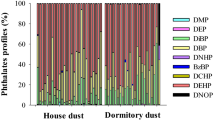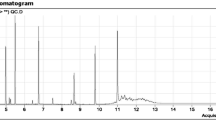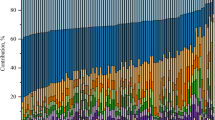Abstract
The phthalate concentrations in dust from undergraduate dormitories, classrooms, and homes in Beijing, China, were measured in April 2017. We analyzed the characteristics of phthalates in dust from three environments. In addition, we estimated the daily intake of phthalates via three pathways using Monte Carlo simulations. The detection frequency of eight phthalates in dust ranges from 74.5 to 100%. Di (2-ethylhexyl) phthalate (DEHP), di-n-butyl phthalate (DnBP), and di-isobutyl phthalate (DiBP) are the most abundant phthalates. The median proportion of DEHP in dust is the highest, ranging from 67.1 to 72.9%. The PMF results indicated that two, four, and three types of phthalate sources exist in home, dormitory, and classroom, respectively. The differences in the phthalate concentrations between sunny and shaded rooms and urban and suburban classrooms are insignificant, whereas that between male and female dormitories is significant. The total daily intake of DEHP, DnBP, and DiBP ranges from 97.3 to 336 ng/ (kg·day). The oral intake for DEHP in classrooms and the dermal intake of DnBP and DiBP in homes are the highest. The carcinogenic risk of DEHP to university students is the highest in classrooms and the total carcinogenic risk of the three environments is 4.70 × 10-6.




Similar content being viewed by others
References
Abb M, Heinrich T, Sorkau E, Lorenz W (2009) Phthalates in house dust. Environ Int 35:965–970
Bamai YA, Araki A, Kawai T, Tsuboi T, Saito I, Yoshioka E, Kanazawa A, Tajima S, Shi C, Tamakoshi A, Kishi R (2014) Associations of phthalate concentrations in floor dust and multi-surface dust with the interior materials in Japanese dwellings. Sci Total Environ 468–469:147–157
Bamai YA, Araki A, Kawai T, Tsuboi T, Saito I, Yoshioka E, Cong S, Kishi R (2016) Exposure to phthalates in house dust and associated allergies in children aged 6-12 years. Environ Int 96:16–23
Basaran B, Soylu GN, Civan MY (2020) Concentration of phthalate esters in indoor and outdoor dust in Kocaeli, Turkey: implications for human exposure and risk. Environ Sci Pollut Res 27:1808–1824
Bekö G, Weschler CJ, Langer S, Callesen M, Toftum J, Clausen G (2013) Children's phthalate intakes and resultant cumulative exposures estimated from urine compared with estimates from dust ingestion, inhalation and dermal absorption in their homes and daycare centers. PLoS One 8(0062442):1–18
Berger K, Eskenazi B, Kogut K, Parra K, Lustig RH, Greenspan LC, Holland N, Calafat AM, Ye XY, Harley KG (2018) Association of prenatal urinary concentrations of phthalates and bisphenol and pubertal timing in boys and girls. Environ Health Perspect 126:097004
Bergh C, Torgrip R, Emenius G, Ostman C (2011) Organophosphate and phthalate esters in air and settled dust–a multi-location indoor study. Indoor Air 21:67–76
Bi CY, Liang YR, Xu Y (2015a) Fate and transport of phthalates in indoor environments and the influence of temperature: a case study in a test house. Environ Sci Technol 49:9674–9681
Bi XL, Yuan SJ, Pan XJ, Winstead C, Wang QQ (2015b) Comparison, association, and risk assessment of phthalates in floor dust at different indoor environments in Delaware, USA. J Environ Sci Health Part A 50:1428–1439
Bølling AK, Sripada K, Becher R, Bekö G (2020) Phthalate exposure and allergic diseases: Review of epidemiological and experimental evidence. Environ Int 139:105706
Brown SG, Eberly S, Paatero P, Norris GA (2015) Methods for estimating uncertainty in PMF solutions: examples with ambient air and water quality data and guidance on reporting PMF results. Sci Total Environ 518:626–635
Bu ZM, Zhang YP, Mmereki D, Yu W, Li BZ (2016) Indoor phthalate concentration in residential apartments in Chongqing, China: implications for preschool children’s exposure and risk assessment. Atmos Environ 127:34–45
Bu ZM, Mmereki D, Wang JH, Dong C (2019) Exposure to commonly-used phthalates and the associated health risks in indoor environment of urban China. Sci Total Environ 658:843–853
Chemical Economics Handbook (Plasticizers) (2018). https://ihsmarkit.com/products/plasticizers-chemical-economics-handbook.html. Accessed Sept 30 2020
Clausen PA, Liu Z, Kofoed-Sorensen V (2012) Influence of temperature on the emission of di–(2–ethylhexyl) phthalate (DEHP) from PVC flooring in the emission cell FLEC. Environ Sci Technol 46:909–915
CPSC, (2011) staff toxicity review of two phthalates and one phthalate alternative for consideration by the Chronic Hazard Advisory Panel. Memorandum from L Patton, via M Babich and L Saltzman, to MA Danello. Available online: http://www.cpsc.gov/PageFiles/125715/DMEP.pdf.
Dostalova P, Zatecka E, Ded L, Elzeinova F, Valaskova E, Kubatova A, Korenkova V, Langerova L, Komrskova K, Peknicova J (2020) Gestational and pubertal exposure to low dose of di-(2-ethylhexyl) phthalate impairs sperm quality in adult mice. Reprod Toxicol 96:175–184
EPA, U.S, (1997), Di (2–ethylhexyl) phthalate (DEHP) (CASRN 117-81-7). Available online at: https://cfpub.epa.gov/ncea/iris/iris_documents/documents/subst/0014_summary.pdf
EPA, U.S, (2000), Exposure and human health reassessment of 2,3,7,8-tetrachlorodibenzo–p–dioxin (TCDD) and related compounds. Part 1: estimating exposure to dioxin-like compounds. National Center for Environmental Assessment, Office of Research and Development. EPA/600/P–00/001B (b–d)
EPA, U.S., (2014) EPA Positive Matrix Factorization (PMF) 5.0 Fundamentals and User Guide (Washington, DC 20460)
Fan GT, Xie JC, Yoshino H, Zhang HB, Li ZH, Li NP, Liu J, Lv Y, Zhu SW, Yanagi U, Hasegawa K, Kagi N, Zhang XJ, Liu JP (2018) Common SVOCs in house dust from urban dwellings with schoolchildren in six typical cities of China and associated non-dietary exposure and health risk assessment. Environ Int 120:431–442
Feng YX, Feng NX, Zeng LJ, Chen X, Xiang L, Li YW, Cai QY, Mo CH (2020) Occurrence and human health risks of phthalates in indoor air of laboratories. Sci Total Environ 707:135609
Fierens T, Servaes K, Holderbeke MV, Geerts L, Henauw SD, Sioen I, Vanermen G (2012) Analysis of phthalates in food products and packaging materials sold on the Belgian market. Food Chem Toxicol 50:2575–2583
Fromme H, Lahrz T, Piloty M, Gebhart H, Oddoym A, Ruden H (2004) Occurrence of phthalates and musk fragrances in indoor air and dust from apartments and kindergartens in Berlin (Germany). Indoor Air 14:188–195
Fromme H, Lahrz T, Kraft M, Fembacher L, Dietrich S, Sievering S, Burghardt R, Schuster R, Bolte G, Volkel W (2013) Phthalates in German daycare centers: occurrence in air and dust and the excretion of their metabolites by children (LUPE 3). Environ Int 61:64–72
Gaspar FW, Castorina R, Maddalena RL, Nishioka MG, Mckone TE, Bradman A (2014) Phthalate exposure and risk assessment in California child care facilities. Environ Sci Technol 48:7593–7601
Gómez-Hens A, Aguilar-Caballos MP (2003) Social and economic interest in the control of phthalic acid esters. Trends Anal Chem 22:847–857
Gong MY, Zhang YP, Weschler CJ (2014) Measurement of phthalates in skin wipes: estimating exposure from dermal absorption. Environ Sci Technol 48:7428–7435
Guo Y, Kannan K (2011) Comparative assessment of human exposure to phthalate esters from house dust in China and the United States. Environ Sci Technol 45:3788–3794
He RW, Li YZ, Xiang P, Li C, Zhou CY, Zhang SJ, Cui XY, Ma LQ (2016) Organophosphorus flame retardants and phthalate esters in indoor dust from different microenvironments: bioaccessibility and risk assessment. Chemosphere. 150:528–535
Hsu NY, Lee CC, Wang JY, Li YC, Chang HW, Chen CY, Bornehag CG, Wu PC, Sundell J, Su HJ (2012) Predicted risk of childhood allergy, asthma, and reported symptoms using measured phthalate exposure in dust and urine. Indoor Air 22:186–199
Huang CN, Chiou YH, Cho HB, Lee CW (2019) Children’s exposure to phthalates in dust and soil in Southern Taiwan: a study following the phthalate incident in 2011. Sci Total Environ 696:133685
Kamrin MA (2009) Phthalate Risks, Phthalate Regulation, and Public Health: A Review. J Toxicol Environ Health B Crit Rev 12:157–174
Kelly TJ, Mukund R, Spicer CW, Pollack AJ (1994) Concentrations and Transformations of Hazardous Air Pollutants. Environ Sci Technol 28:378A–387A
Kim W, Lee S, Shin MY, Kim KN, Kim YC (2013) Phthalates Levels in Nursery Schools and Related Factors. Environ Sci Technol 47:12459–12468
Langer S, Weschler CJ, Fischer A, Bekö G, Toftum J, Clausen G (2010) Phthalate and PAH concentrations in dust collected from Danish homes and daycare centers. Atmos Environ 44:2294–2301
Larsson K, ChoI I, Jung Y, Lee J, Min S, Yoon C (2017) Phthalates, non-phthalate plasticizers and bisphenols in Swedish preschool dust in relation to children's exposure. Environ Int 102:114–124
Li HL, Song WW, Zhang ZF, Ma WL, Gao CJ, Li J, Huo CY, Mohammed MOA, Liu LY, Kannan K, Li YF (2016) Phthalates in dormitory and house dust of northern Chinese cities: occurrence, human exposure, and risk assessment. Sci Total Environ 565:496–502
Li YH, Lu JJ, Yin XW, Liu ZL, Tong YB, Zhou L (2019) Indoor phthalate concentrations in residences in Shihezi, China: implications for preschool children’s exposure and risk assessment. Environ Sci Pollut Res 26:19785–19794
Liu K, Kang LY, Li A, Zheng JC, Wang XK, Zhou XJ, Wang FH (2020) Field investigation on phthalates in settled dust from five different surfaces in residential apartments. Build Environ 177:106856
McKone TE, 1993. CalTOX, A Multimedia Total-exposure Model for Hazardous wastes Sites Part II: the dynamic multimedia transport and transformation model, Lawrence Livermore National Laboratory: Department of Toxic Substances Control, California Environmental Protection Agency.
Meeker JD, Calafat AM, Hauser R (2007) Di (2-ethylhexyl) phthalate metabolites may alter thyroid hormone levels in men. Environ Health Perspect 115:1029–1034
Meng ZY, Wang LX, Cao BK, Huang ZS, Liu F, Zhang JP (2020) Indoor airborne phthalates in university campuses and exposure assessment. Build Environ 180:107002
Miao YF, Wang RH, Lu C, Zhao JP, Deng QH (2017) Lifetime cancer risk assessment for inhalation exposure to di (2-ethylhexyl) phthalate (DEHP). Environ Sci Pollut Res 24:312–320
Oie L, Hersoug LG, Madsen JO (1997) Residential exposure to plasticizers and its possible role in the pathogenesis of asthma. Environ Health Perspect 105:972–978
Paatero P, Tapper U (1994) Positive matrix factorization: a non-negative factor model with optimal utilization of error estimates of data values. Environmetrics 5(2):111–126
Pei XQ, Song M, Guo M, Mo FF, Shen XY (2013) Concentration and risk assessment of phthalates present in indoor air from newly decorated apartments. Atomos Environ 68:17–23
Qiao PW, Dong N, Yang SC, Gou YL (2021) Quantitative analysis of the main sources of pollutants in the soils around key areas based on the positive matrix factorization method. Environ Pollut 273:116518
Quintana-Belmares RO, Krais AM, Esfahani BK, Rosas-Pérez I, Mucs D, López-Marure R, Bergman Å, Alfaro-Moreno E (2018) Phthalate esters on urban airborne particles: Levels in PM 10 and PM 2.5 from Mexico City and theoretical assessment of lung exposure. Environ Res 161:439–445
Shin H-M, Moschet C, Young TM, Bennett DH (2020) Measured concentrations of consumer product chemicals in California house dust: Implications for sources, exposure, and toxicity potential. Indoor Air 30:60–75
Stahlhut RW, Van-Wijingaarden E, Dye TD, Cook S, Swan SH (2007) Concentrations of urinary phthalate metabolites are associated with increased waist circumference and insulin resistance in adult U.S. males. Environ. Health Perspect 115:876–882
Su TC, Hwang JS, Torng PL, Wu C, Lin CY, Sung FC (2019) Phthalate exposure increases subclinical atherosclerosis in young population. Environ Pollut 250:586–593
Sun YX, (2007). On the association between dorm environmental factors and allergies among college students. Tianjin University, (In Chinese).
Valvi D, Casas M, Romaguera D, Monfort N, Ventura R, Martinez D, Sunyer J, Vrijheid M (2015) Prenatal phthalate exposure and childhood growth and blood pressure: evidence from the Spanish INMA–Sabadell birth cohort study. Environ Health Perspect 123:1022–1029
Velázquez-Gómez M, Hurtado-Fernández E, Lacorte S (2019) Differential occurrence, profiles and uptake of dust contaminants in the Barcelona urban area. Sci Total Environ 648:1354–1370
Wang W, Wu FY, Huang MJ, Kang Y, Cheung KC, Wong MH (2013) Size fraction effect on phthalate esters accumulation, bioaccessibility and in vitro cytotoxicity of indoor/outdoor dust, and risk assessment of human exposure. J Hazard Mater 261:753–762
Wang XK, Tao W, Xu Y, Feng JT, Wang FH (2014) Indoor phthalate concentration and exposure in residential and office buildings in Xi’an, China. Atmos Environ 87:146–152
Wang LX, Gong MY, Xu Y, Zhang YP (2017) Phthalates in dust collected from various indoor environments in Beijing, China and resulting non-dietary human exposure. Build Environ 124:315–322
Wang LX, Wu ZX, Gong MY, Xu Y, Zhang YP (2020) Non–dietary exposure to phthalates for pre-school children in kindergarten in Beijing, China. Build Environ 167:106438
Weschler CJ, Nazaroff WW (2008) Semivolatile organic compounds in indoor environments. Atmos Environ 42:9018–9040
Weschler CJ, Nazaroff WW (2010) SVOC partitioning between the gas phase and settled dust indoors. Atmos Environ 44:3609–3620
Whyatt RM, Liu XH, Rauh VA, Calafat AM, Just AC, Hoepner L, Diaz D, Quinn J, Adibi J, Perera FP, Factor-Litvak P (2012) Maternal prenatal urinary phthalate metabolite concentrations and child mental, psychomotor, and behavioral development at 3 Years of age. Environ Health Perspect 120:290–295
Wormuth M, Scheringer M, Vollenweider M, Hungerbühler K (2006) What are the sources of exposure to eight frequently used phthalic acid esters in Europeans? Risk Anal 26:803–824
Wu YX, Cox SS, Xu Y, Liang YR, Won DY, Liu XY, Clausen PA, Rosell L, Benning JL, Zhang YP (2016) A reference method for measuring emissions of SVOCs in small chambers. Build Environ 95:126–132
Xie C, Zhao Y, Gao L, Chen J, Cai D, Zhang Y (2015) Elevated phthalates’ exposure in children with constitutional delay of growth and puberty. Mol Cell Endocrinol 407:67–73
Xie XM, Deng T, Duan JF, Ding SM, Yuan JL, Chen MQ (2019) Comparing the effects of diethylhexyl phthalate and dibutyl phthalate exposure on hypertension in mice. Ecotoxicol Environ Saf 174:75–82
Xu Y, Liang Y, Urquidi JR, Siegel JA (2015) Semi-volatile organic compounds in heating, ventilation, and air-conditioning filter dust in retail stores. Indoor Air 25:79–92
Xu HL, Wu XY, Liang CM, Shen J, Tao SM, Wen X, Liu WW, Zou LW, Yang YJ, Xie Y, Jin ZX, Li TT, Tao FB (2020) Association of urinary phthalates metabolites concentration with emotional symptoms in Chinese university students. Environ Pollut 262:114279
Zhang Q, Lu XM, Zhang XL, Sun YG, Zhu DM, Wang BL, Zhao RZ, Zhang ZD (2013) Levels of phthalate esters in settled house dust from urban dwellings with young children in Nanjing, China. Atmos Environ 69:258–264
Zhang YH, Cao Y, Shi HJ, Jiang XX, Zhao Y, Fang X, Xie CM (2015) Could exposure to phthalates speed up or delay pubertal onset and development? A 1.5-year follow up of a school-based population. Environ Int 83:41–49
Zhang QH, Sun YX, Zhang QN, Hou J, Wang P, Kong XR, Sundell J (2020) Phthalate exposure in Chinese homes and its association with household consumer products. Sci Total Environ 719:136965
Zhang M, Deng YL, Liu C, Chen PP, Luo Q, Miao Y, Cui FP, Wang LQ, Jiang M, Zeng Q (2021) Urinary phthalate metabolite concentrations, oxidative stress and thyroid function biomarkers among patients with thyroid nodules. Environ Pollut 272:116416
Zhou LT, Chen HJ, Xu Q, Han X, Zhao YM, Song XY, Zhao TY, Ye L (2019) The effect of di-2-ethylhexyl phthalate on inflammation and lipid metabolic disorder in rats. Ecotoxicol Environ Saf 170:391–398
Zhou XJ, Lian JL, Cheng Y, Wang XK (2021) The gas/particle partitioning behavior of phthalate esters in indoor environment: Effects of temperature and humidity. Environ Res 194:110681
Zou DK, Wang FM, Jiao J, Zhang LB, Ji YQ, Shan CY (2013) Pollution characteristics of PAEs derived from indoor settled dust of dormitory and exposure assessment in summer. China Environ Sci 33:2075–2080 (In Chinese)
Acknowledgements
The authors thank Wiley Editing Services (hwileyeditingservices.com) for its linguistic assistance during the preparation of this manuscript.
Availability of data and materials
The datasets used and/or analyzed during the current study are available from the corresponding author on reasonable request.
Funding
This study was supported by Beijing Science and Technology Planning Project (Z191100004419002) and the Fund of Beijing Municipal Commission of Education (KM201410016014).
Author information
Authors and Affiliations
Contributions
Conceptualization: Lixin Wang, Fang Liu; Data curation: Meinan Qu, Lixin Wang; Formal analysis and investigation: Meinan Qu, Yi Zhao, Xiangzhao Shi, Sijia Li; Methodology: Lixin Wang, Fang Liu; Writing-original draft preparation: Meinan Qu; Writing-review and editing: Lixin Wang, Fang Liu; Funding acquisition: Lixin Wang, Fang Liu. All authors approved the final manuscript as submitted.
Corresponding author
Ethics declarations
Ethics approval and consent to participate
Not applicable.
Consent for publication
Not applicable.
Competing interests
The authors declare that they have no competing interests.
Additional information
Responsible Editor: Constantini Samara
Publisher’s note
Springer Nature remains neutral with regard to jurisdictional claims in published maps and institutional affiliations.
Practical Implications
This is the first report on the characteristics of phthalates in dust from undergraduate living environments and non-dietary exposure in China. di (2-ethylhexyl) phthalate (DEHP), di-n-butyl phthalate (DnBP), and di-isobutyl phthalate (DiBP) are the most abundant phthalates. The difference of phthalate concentrations is significant between male and female dormitories. The oral intake of DEHP in classrooms and dermal intake of DnBP and DiBP in homes are the highest. The carcinogenic risk value of DEHP is the highest in classrooms, and that is 4.70 × 10-6 in three environments. The study provides valuable information on phthalate characteristics in dust in undergraduate living environments. The results can be used to develop strategies for the reduction of the phthalate exposure of college students.
Supplementary Information
ESM 1
(DOCX 502 kb)
Rights and permissions
About this article
Cite this article
Qu, M., Wang, L., Liu, F. et al. Characteristics of dust-phase phthalates in dormitory, classroom, and home and non-dietary exposure in Beijing, China. Environ Sci Pollut Res 28, 38159–38172 (2021). https://doi.org/10.1007/s11356-021-13347-1
Received:
Accepted:
Published:
Issue Date:
DOI: https://doi.org/10.1007/s11356-021-13347-1




